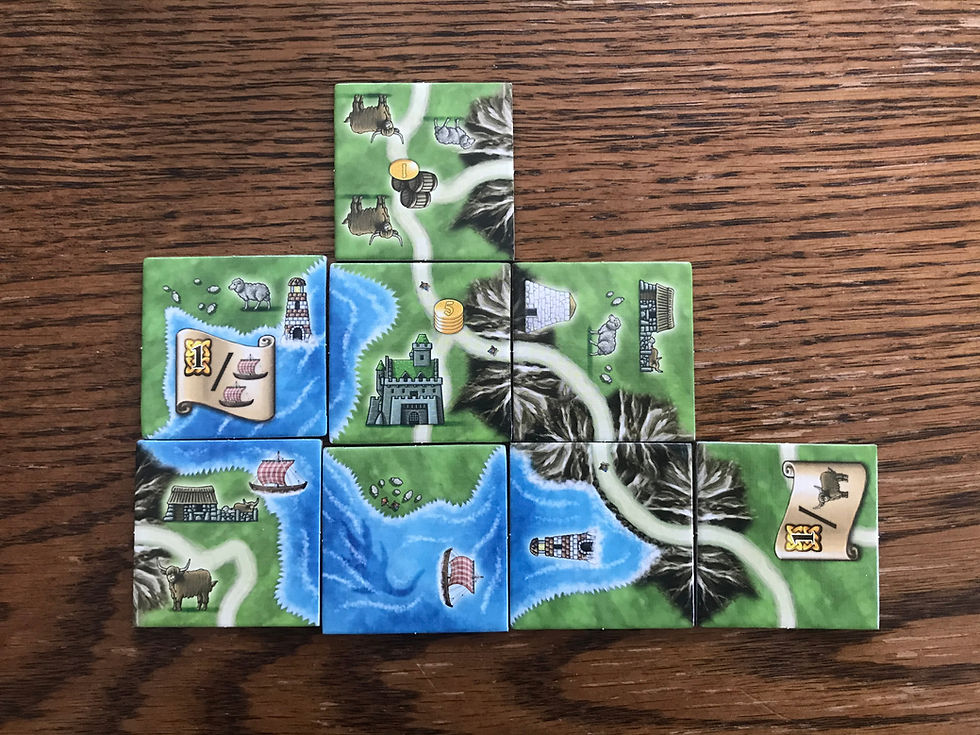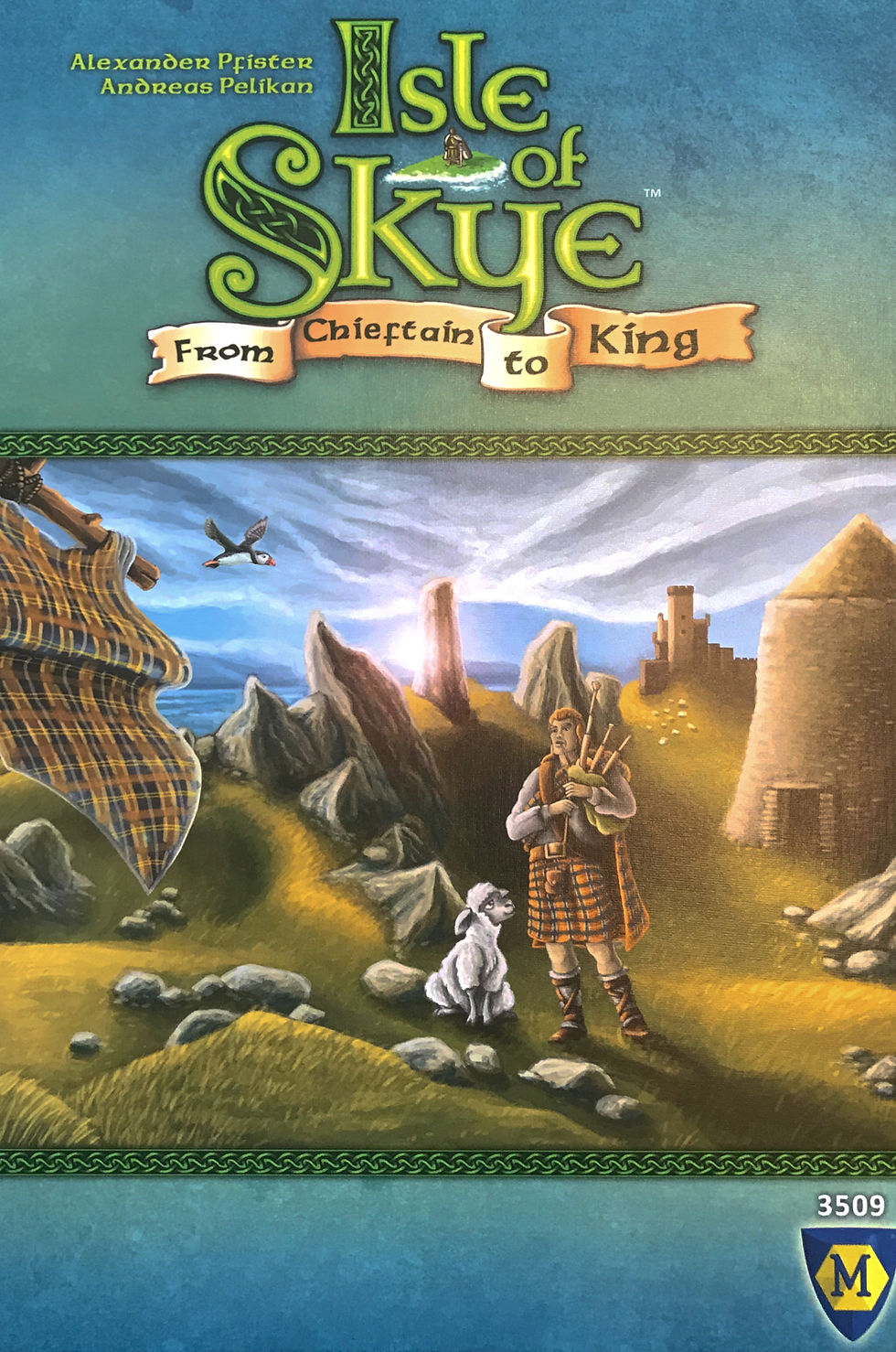Isle of Skye: From Chieftain to King
- Chris

- Mar 30, 2020
- 7 min read
Updated: Aug 16
Category: Euro Game
Designer: Andreas Pelikan, Alexander Pfister
Publisher: Mayfair Games (2016 English edition)
Year Published: 2015
Players: 2-5
Playing Time: 30-60 mins.
To Play or Not To Play: Play
Tiles are such simple things. Each one is a simple geometric shape that can be arranged with others to form a pattern. The earliest were surely made of ceramic, as forming and baking clay into shapes is one of humanity’s oldest technologies. At some point, that technology made the jump from art to game design when the first tile-placement games were created. I don’t have any evidence of this, but I think Dominoes are one of the oldest tile-placement games in existence. Each domino has an identical back, but a unique front. You can randomize them by mixing them on the table, deal out tiles to players, and then play them out in ways that form patterns according to the rules.
As technology has developed, humans have made tiles out of other materials: wood, plastic, linoleum, and even cardboard. Today, tile-placement games are a fixture of the board game industry thanks to thick cardboard tiles and modern printing technology. In 2000, Hans im Glück published Carcassonne, a family friendly tile-placement game, in Germany. The game was a humongous success, went on to win the Spiel des Jahres award at Essen in 2001, and spread around the world soon after.
Carcassonne’s premise is simple. The game starts with a single tile face up in the center of the table. The rest of tiles are mixed up randomly. On a player’s turn, they draw a tile and add it to the other tiles in play. The player has to match the art on each edge of the tile with the tiles they are trying to place it adjacent too. Each tile has different ways to score points depending on the art printed on the top. The game continues until all the tiles have been played.

I don’t want to get too distracted talking about Carcassonne, so let’s just say that the game is so fun that it is still in print 20 years later. Very few games have reached that sort of “evergreen” status, and Carcassonne achieved that through simple, accessible rules and excellent production quality. As fun as Carcassonne is as a challenge to accumulate points, it’s also fun to just hold, mix, and rotate the tiles. They feel great, the art is functional and clear, and it’s so satisfying to get everything to line up nicely..
Carcassonne’s immense success inspired plenty of other games. One of the more recent to hit the market is Isle of Skye: From Chieftain to King. Isle of Skye takes Carcassonne’s pattern-matching and placement mechanics and adds more strategic decision-making to the process. Allow me to explain.

Each player begins by drawing three tiles out of a bag and placing them behind their player screen. The players each have a small amount of money and an axe token. They must assign some number of coins to two of the tiles, anywhere from 0 to all of their available money, and the axe to the third. Then all players simultaneously reveal their tiles. All tiles with an axe get immediately discarded back into the tile bag.

Now comes the meat of the game. The player with the first player marker may now purchase any tile from another player for the price that player assigned the tile. But, the coins that are attached to the tile to set the value are not available to be spent. I’ll explain why later. So if a player assigns all of their coins to the tiles in front of them, they won’t have any money left over to purchase tiles from the other players.
Once the first player has purchased or passed, the second player gets and chance, and so on until every player has had one opportunity to purchase a tile. Once a tile has been purchased, it cannot be re-purchased by any other player. However, the player who sold the tile not only gets the money they sold it for, but they also recoup the money they used to set the price. Thus, the first player potentially has the least money to make purchases with, while the last player could have tons of money, but very few options. It’s ends up feeling very well balanced, in that it will always feel unfair no matter where you are in the turn order.
Okay, so everyone has had an opportunity to purchase a tile. What happens to the rest? The player who set the price must now purchase the tile for that price, and the money goes into the game’s supply. This means if no one buys your tiles, you’ll get two new tiles, plus the one you may have purchased. Conversely, if you price your tiles too low, someone might buy both of yours, and if you don’t plan ahead you may not be able to purchase one, or the one you purchase might not be useful for you. In other words, Instead of a guaranteed 1 tile per round, each player can get between 0 and 3, depending on how well they price their tiles.

And that’s where a lot of the decision-making shows up in this game. Do you price your tiles high to make sure you get them? Do you price them low so you have plenty of money to purchase other peoples’ tiles? A combination? What if the tile you drew is worthless to you, but essential for another player? Do you raise the price higher in hopes of attracting that player so you have more money for a future round? Or do you axe that tile so they get fewer points?
Once all the tiles have been purchased, it’s time to place them on the tableau. Unlike Carcassonne, each player begins with their own start tile. Like other tile placement games, the edges of the tile have to match the edges of the other tiles you place them next to. EXCEPT, for some reason, roads to do not have to line up. Roads can dead-end into mountains or fields. Honestly, keeping that in mind is one of the most difficult parts of this game. In Carcassonne, matching roads is a significant part of the game, so switching from that to Isle of Skye can be a jarring experience.

Once all the tiles are placed, it’s time for everyone to score points for that round. And this is where things get really wild. In Isle of Skye, the way you score points is different every round. At the beginning of the game, four scoring tiles are dealt onto the score board. Each tile illustrates a different way to score points. One might earn you points for each sheep depicted on your tiles. Another might earn you points for every 2x2 square of tiles connected in your tableau. Or one might give you points for each tile connected to your starting tile via roads. In the first round, players will score points based on the criteria shown on the dealt onto space A on the score board. In round 2, it will be based on space B. But in round 3, it’ll be scoring tiles A AND C that generate points. All four scoring tiles are public knowledge, so you can plan ahead for later rounds while also trying to earn points early on to stay in the running.
Once scoring is over, the next round begins. The start player marker rotates clockwise and each player earns income. Income is based on how many tiles that depict Whiskey barrels are connected to your starting tile by roads. So even if you spend all your money in the previous round, you’ll have something to work with in the new round to price your tiles and make a purchase.

After six rounds, the game ends. Each scoring tile will have been used three times by then, but obviously you’ll have fewer tiles to work with earlier in the game than later. After the sixth round is over, players will score their bonus points. Certain tiles in the game have “scrolls,” which will earn you victory points for each item displayed in the scroll that exists in your tableau. For example, one might give you one point for every granary you have.

As you can see, this is a moderately complex game. Scoring changes with every game, so you can’t just come up with one or two strategies to follow every game. You have to adapt to what tiles appear and what scoring tiles are in play. And even then, the other players may make unexpected decisions in pricing or purchasing tiles that will force you to re-evaluate constantly. And for all those reasons, I absolutely love Isle of Skye. Every decision is meaningful, and the purchase round simultaneously rewards skilled play while also serving as a balancing mechanism.
Isle of Skye is also gorgeous. The tiles capture the bucolic beauty of the Scottish highlands, and the mechanical elements on each tile are easy to see. The only problem with the game is that the tiles are also very busy. In addition to the landscape features that dictate where you can place a tile, you’ll see roads, livestock, boats, or extra victory point scrolls all piled on a single tile. All of these pieces of art are mechanically significant, so for your first few games you may be a bit overwhelmed by the visual complexity. But after a couple games, you’ll learn to ignore the art that isn’t relevant to the four scoring tiles and just focus on the pieces on what matters in the moment.

Isle of Skye is not an easy game. If you want to win, you’ll need to combine long-term strategy with copious short-term improvisation. But that’s a combination I adore in a game. Isle of Skye plays well with 2-4 players, and has components and rules for a five-player game as well (same as the four player game, but only five rounds long). Every game I’ve played has been challenging, dynamic, and super fun. You should play this game.
Want a say in which game I review next week? Follow me on Twitter @OrNotToPlay so your vote can be heard! You can also leave suggestions in the comments below. See you next week!






Comments